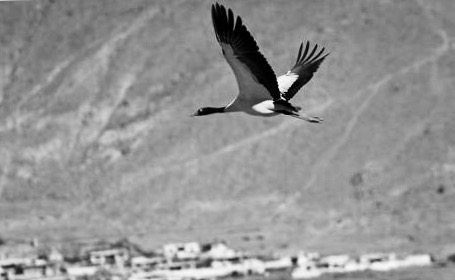2017-09-26

白鹤飞过图伯特。(网络图片/唯色提供)
那天下午,阳光透过藏式格子窗户而入
似乎稀释了烈度,宜于怀旧
擅写回文诗的噶雪•伦珠朗杰先生
用美妙的敬语娓娓说起仓央嘉措的诗
正是那首寄予淙淙嘎波[1]的预言:
“……请借双翅,飞不多远,理塘即归。”
以素来谦恭的手势指向身后
如同邀我随他重返——
“往昔拉萨北面有条流沙河,
延绵的细沙滩怕是全世界也没有。
白鹤夏天飞来,冬天飞走,
这些起舞,那些落下,
见到的人都心生愉悦。”
“六世尊者从高高的颇章布达拉望去,
必定常常目睹那样的景象,
他是这样的了然美,
所以在无常的险象中,
挑选了白鹤来传递转世的讯息。”
先生的脸上浮现忧伤的笑容
抬起另一只手臂如同无力地振翅:
“即便是1950年代那时候,
自己同小伙伴上学的路上,
也见过白鹤飞飞停停,就模仿,
双手展开欢笑追逐是最爱的游戏。
但以后,以后再也见不到了……”
那天下午,阳光透过藏式格子窗户而入
似乎稀释了烈度,也适于心碎
2017-8-20,北京
注释:
[1]淙淙嘎波:ཁྲུང་ཁྲུང་དཀར་པོ་། 藏语,白鹤。六世达赖喇嘛仓央嘉措预言七世将诞生在康区理塘的诗写道:“洁白的鹤,请借双翅,飞不多远,理塘即归。”
White Crane
That afternoon, sunlight
passed through the Tibetan-style latticed window
and entered, its intensity diluted
suitably nostalgic.
Kasho Lumdup Namgyal,
who is an expert at writing revolving verse,
gave a talk, his language wonderfully noble
as he spoke in detail about Gayatso’s poetry.
He emphasized the prophetic poem
about the trung trung karpo:
… please lend me your wings
I won’t fly far
just to Lithang and back.
And throughout his lecture he gestured humbly,
lifting one palm and pointing to his back,
as if inviting me to follow him.
“In the past, to the north of Lhasa
there once existed the Je Rak River,
a continuous stretch of fine sand
the likes of which I’m afraid
no longer exist in the whole world.
Pure white cranes would arrive in the summer,
and in the winter they would leave,
some of them dancing,
some of them alighting,
and the hearts of those who saw them
bloomed with delight and contentment.
“The sixth Dalai Lama looking out
from the highest terrace of the Phodrang Potala
must have often seen this kind of scene
and in this way he clearly understood beauty.
Thus, while surrounded by the perils of impermanence,
he chose the white crane to convey
the message of reincarnation.”
A sad smile floated to the surface of his face
and he lifted his other arm
as if he lacked the strength to flap his wings:
“Even during the 1950s,
as my friends and I walked the road to school,
we also saw white cranes flying and landing.
We imitated them, our arms stretched out in mirth,
chasing each other—it was the game we loved the most.
But after that,
after that we never saw them again…”
That afternoon, sunlight
passed through the Tibetan-style latticed window
and entered, its intensity diluted
suitable for a broken heart.
Woeser
August 20, 2017
Beijing
Translated by Ian Boyden
September 23, 2017
San Juan Island, WA
[1] Tsangyang Gyatso (ཚངས་དབྱངས་རྒྱ་མཚོ, 1683–1706), the sixth Dalai Lama, was a celebrated poet and songwriter, whose verses remain popular to this day.
[2] trung trung kar po (ཁྲུང་ཁྲུང་དཀར་པོ་།): Tibetan word meaning “white crane,” or Siberian crane (Leucogeranus leucogeranus). It is said that Gyatso, predicted that the seventh Dalai Lama would be born in Litang in Kham, and he wrote this poem:
White crane
please lend me your wings
I won’t fly far
just to Lithang and back.
Today, the Siberian crane is critically endangered and has been extirpated from Tibet, the only population left exists in western China around Lake Poyang.
[3] Woeser used the Chinese name for this river, 流沙河, which means “Flowing Sand River.” The Tibetan name, བྱེ་རགས།, means “sandy bank.”
[4] Phodrang Potala: the Tibetan name for the Potala Palace, the traditional home of the Dalai Lamas and seat of Tibetan government until 1959.
RFA
